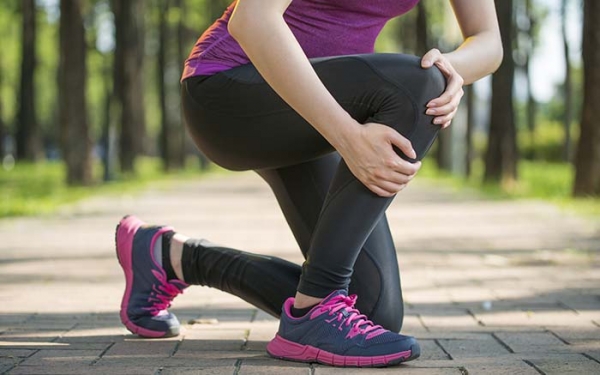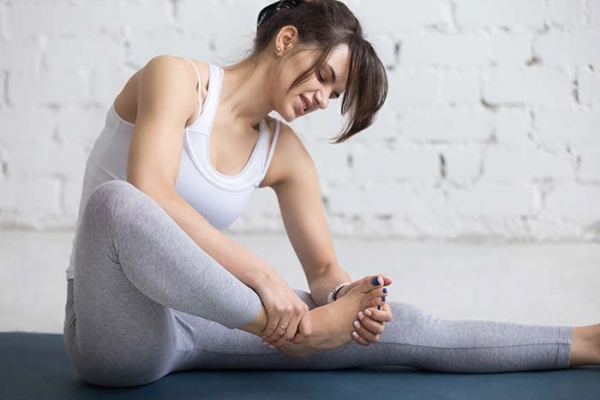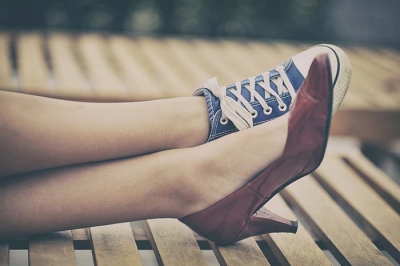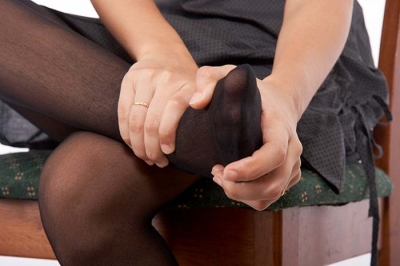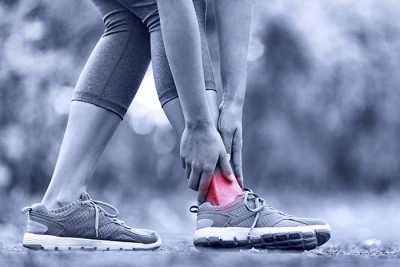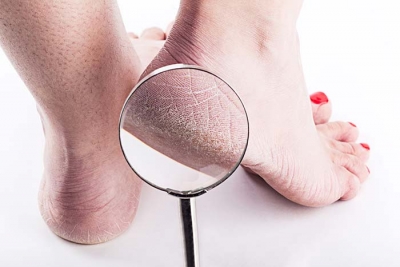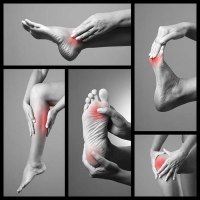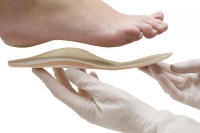Connect With Us
Blogs

Health Tips (46)
You may be surprised to learn that a lot of the problems you have with your feet might also be the cause of your knee pain. Here’s a quick look at some of the conditions and diseases that can cause a combination of foot and knee pain.
Flat Feet
Many people with flat feet find that their ankles roll inward with each step. This excessive inward rotation of the ankle, tendons, and ligaments connecting the muscles and bones of the heel and shin bone will cause the inside of the lower leg to stretch further than the outside. As the lower leg is pulled out of line, the knee fails to track straight, causing knee pain.
There are a few ways in which you can tell if you have flat feet:
- Get your feet wet and make an impression on a dry patch of flooring. The inside of the impression should be dry, as a healthy arch wouldn’t have made contact with the floor.
- Place the soles of your feet together. Check to see if each instep is virtually in contact along the length of your feet, or whether there is a good parting of the feet around the midsection.
- See if you can comfortably insert your thumb under your instep while standing.
Osteoarthritis
Osteoarthritis occurs when the protective cartilage one the ends of your bones wears down over time. With osteoarthritis, the slick surface of the cartilage becomes rough and may eventually wear down completely, causing bone to rub on bone. It can damage any joint in your body, including your feet and your knees.
The symptoms of osteoarthritis often develop slowly and worsen over time. Symptoms include:
- Pain
- Tenderness
- Stiffness
- Loss of flexibility
- Grating sensation
- Bone spurs (extra bits of bone that feel like hard lumps)
Rheumatoid Arthritis
Rheumatoid arthritis is a chronic inflammatory disorder that can affect more than just your joints. In some people, the condition can also damage a wide variety of the body’s systems, including the skin, eyes, lungs, heart, and blood vessels. Rheumatoid arthritis affects the lining of your joints, causing a painful swelling that can eventually result in bone erosion and joint deformity.
The condition occurs when your immune system attacks the synovium (the lining of the membranes that surround your joints). The resulting inflammation thickens the synovium, which can eventually destroy the cartilage and bone within the joint. The tendons and ligaments that hold the joint together weaken and stretch, gradually causing the joint to lose its shape and alignment.
Tendinitis
Tendinitis, or tendonitis, is an inflammation or irritation of a tendon (a thick cord that attaches the bone to muscle. It is most often caused by repetitive, minor impact on the affected area, or from a sudden more serious injury. Incorrect posture at work or home, or poor stretching or conditioning before exercise may increase your risk of tendinitis. Tendinitis can occur almost anywhere in the body where a tendon connects muscle to bone, and can affect anyone of any age.
Symptoms of tendinitis include:
- Pain at the site of the tendon and surrounding area
- Loss of motion
Bursitis
Bursitis in a painful condition that affects the small, fluid filled sacs (bursae) that cushion the bones, tendons, and muscles near your joints. Bursitis occurs when bursae become inflamed, and most often occurs in joints that perform frequent repetitive motion.
Symptoms of bursitis can cause the affected joint to:
- Feel achy or stiff
- Hurt more when you move or press on it
- Look swollen and red
Gout
Gout is characterized by sudden, severe attacks of pain, redness, and tenderness in the joints. It is a complex form of arthritis that can affect anyone, but is more common among men. Gout occurs when urate crystals accumulate in your joint, causing inflammation and intense pain. Urate crystals can form when you have high levels of uric acid in your blood. Your body produces uric acid when it breaks down purines (substances found naturally in your body), as well as steak, organ meats, and seafood.
Symptoms of gout include:
- Intense joint pain
- Lingering discomfort
- Inflammation and redness
- Limited range of motion
Treating Foot and Knee Pain
If you suspect that you have any of the above conditions or diseases, then you should schedule a consultation with Dr. Vikki and Dr. Connie. With years of collective experience in their fields, they have the experience to help you figure out what the root of your problem is.
Addressing Nerve Pain in the Feet
Foot pain isn’t just uncomfortable – it can be debilitating. It’s one thing if you have a physical injury that you can visibly identify and treat on the spot; nerve pain, however, can be a trickier beast to tame. You’ve likely experienced nerve pain in your feet before without knowing its cause: the pins and needles, the tingling, the numbness, muscle weakness, and the sensation that your foot has fallen asleep underneath you.
Nerve pain in the feet can stem from a number of different causes, depending on the specific nerve affected. Here’s a look at the various sources of nerve pain in the feet, and your best available treatment options.
Sciatica
You may be surprised to learn that lower back conditions are closely linked to leg and foot pain. This is due to the connecting sciatic nerve, the largest nerve in your body. The sciatic nerve runs down the spine and along the back of each leg, serving the primary role of connecting the spinal cord to the muscles in the leg and feet. Any damage to the sciatic nerve, such as in the lower spine, can actually manifest as crippling leg and foot pain, a condition known as sciatica. Pain experienced as a result of sciatica is often described by patients as being incredibly sharp, almost like a burning sensation.
Sciatica is not a condition in and of itself, but rather a symptom: the diagnosis would identify the underlying source of the nerve damage, usually a herniated disc in the spine resulting in compression of the sciatic nerve. Consult a specialist trained in treating conditions of the back and spine, and refer to your podiatrist for physical therapy and exercises you can do to relieve the pain in your feet.
Diabetic Neuropathy
Diabetic patients sometimes suffer nerve damage as an unfortunate result of their condition. This nerve damage, called diabetic neuropathy, most dramatically impacts the legs and feet. This causes pain and numbness, along with unpleasant sensations spanning pins and needles, tingling or stinging, and even hyper sensitivity in the affected areas.
Nerve damage is serious, and should be brought to the attention of a medical professional immediately. Since this is a tragic side effect of diabetes, the first plan of action is to consult your primary care doctor about how to better manage your diabetic symptoms. Personally monitoring your blood sugar more vigilantly is key, but your doctor may suggest altering your medication or dosage if your condition is deteriorating. From there, consult a skilled podiatrist about potential therapies or treatments to relieve the nerve pain in your feet.
Morton’s Neuroma
A pinched nerve in the foot, known as Morton’s neuroma, is a benign but painful condition. A neuroma is essentially a thickening of the nerve tissue in the toes, forming a lump-like growth, often found specifically between the third and fourth toes. The main symptom is the sensation of having a pebble lodged beneath the toes, accompanied by cramping, numbness, or tingling. These symptoms are exacerbated by tight and otherwise poor-fitting shoes, most notoriously high heels.
The cause of a neuroma is usually chronic irritation, pressure, or trauma to the nerve. High-heels have been a proven contributor to neuroma growth, along with certain high impact sports such as jogging. Patients with existing foot deformities such as bunions or flat feet are more prone to developing a neuroma.
Your podiatrist will carefully examine your feet for any signs of a growth, and may even perform imaging tests such as an X-ray or ultrasound to confirm the diagnosis. They will likely suggest custom orthotics to remove the weight and pressure from the nerve. If your condition is more severe, surgery may be required to relieve the pressure or remove the affected nerve entirely.
Schedule a Consultation with Dr. Vikki and Dr. Connie
Only a skilled podiatrist can accurately identify the source of your foot pain, and map out the solutions you need. Schedule a consultation with trusted podiatrists Dr. Vikki and Dr. Connie at the Superior Foot & Ankle Care Center for happier, healthier feet today.
Selecting the Best Shoes for Your Feet
Are you tired of having sore, achy feet? Does there seem to be nothing medically wrong with your feet? Then it’s possible you could be wearing shoes that aren’t suited for your feet.
Here are some tips on how you can find the best shoes for your feet, so that you can move around comfortably throughout the day without any foot pain.
Tips on How to Find the Right Shoes
When shopping for the right pair of shoes, you need to keep function and comfort in mind, as well as fashion. These tips can help you choose the right shoes that will help keep your feet in good shape:
- Trace your foot—place any shoe that you might buy on top of your foot tracing. If the shoe is shorter or narrower than the tracing, don’t bother trying it on.
- Measure your foot—feet change with age, often growing larger and wider, so you should have your feet measured every time you buy new shoes. If one foot is larger than the other, buy a size that fits the larger foot.
- Shop in the afternoon—because your feet can swell as much as eight percent throughout the day, the best time to buy shoes is at the end of the day to account for the largest possible size your feet will reach.
- Socks—wear the same type of socks to the store that you intend to wear with the shoes.
- Stand in the shoes—you should have half an inch of space between your toe and the end of the shoe when you’re standing, in order to provide enough room for your foot to press forward when you walk. Wiggle your toes to make sure there’s enough room.
- Walk in the shoes—walk around to determine how the shoes feel. Find shoes that fit from the start, not shoes that need to be “broken in.”
- Trust your comfort level—shoes sizes vary between manufacturers, so don’t exclusively depend on the shoe’s noted size or description.
- Pay attention to width and length—if the ball of your foot feels compressed in a particular shoe, ask if it comes in a wider size. Buying shoes that are half a size bigger won’t necessarily solve the problem.
- Feel inside the shoe—check the shoe for any tags, seams, or other material that may irritate your foot.
- Examine the soles—take note of how they feel when you walk around the store. Try to walk on hard surfaces as well as carpet to see how the shoe feels on both.
- Examine the upper part of the shoes—the top of the shoes should be made of a soft, flexible material to match the shape of your foot. Shoes made of leather can reduce the possibility of skin irritations.
Understanding the Parts of the Shoe
Understanding the different parts of the shoe can help you choose what type of shoe will work best for your feet. The different parts of the shoe include:
- Toe box—the front area of the shoe where the toes rest. The deeper the toe box, the more room for your toes.
- Vamp—covers the top part of the foot at the midsection of the shoe (where the laces are). The vamp should fit snuggly, holding the foot firmly, yet comfortably in place.
- Counter—the back of the shoe that holds the heel in place. A stiff counter offers greater heel control and stability.
- Last—the solid, foot-shaped form (usually made from dense plastic) that the manufacturer uses to create a shoe. There are three categories of lasts: straight, semi-curved, and curved.
- Insole—the inside of the shoe where the main part of the foot rests. Shoes that have removable insoles provide greater flexibility as they can be removed or replaced with a cushioned insole or orthotic.
- Shank—is located under the arch of the foot. The stiffer the shank, the more support it provides.
- Midsole—the material that sits between the upper or top section of the shoe and the outer sole. The softer the material, the more shock absorption in the shoe.
- Outsole—the hard bottom of the shoe (typically made from leather, blown rubber, or man-made materials). It is important to make sure that the shape of the outsole conforms to your foot.
Schedule a Consultation
If you find that changing up the style of your shoes doesn’t help with your foot pain, then you should seek out help from an experienced podiatrist. Book a consultation with Dr. Vikki and Dr. Connie today, so that they can help you get to the bottom of your foot pain.
How to Manage Basic Foot Aches
Foot health is easily taken for granted, especially considering how much work and weight our feet bear day in and day out. However, this is precisely why foot health should be made a top priority: to prevent chronic pain and even disability. Foot pain is common and near inevitable as we grow older, and work our bodies longer and harder. But unlike most things in our adult lives, basic foot aches can be understood, managed, and eventually resolved.
Brushing up on a bit of general foot anatomy is helpful to better understand the source of your pain. It is important to identify the origin of the pain – such as the heel, the arch, the toes, or the balls of your feet – in order to accurately treat a localized injury.
Here are a few tips on identifying the source of your foot aches, and how to manage foot pain in your daily life:
Common Sources of Foot Aches
Your feet require adequate care and support which, in turn, will support overall body. Common sources of foot pain include:
- Poorly-fitting shoes: A proper shoe fit encompasses several factors. This includes the foot length, the shoe depth, the width of the toe box, and more. Have your feet professionally measured at the end of the day, when your feet are largest due to swelling. Also make sure to have the shoes fit your largest foot, as feet are rarely symmetrical.
- Improper support: Proper arch support is necessary, especially if your arches have fallen or your feet tend to pronate. If your shoes are not supportive enough, purchase custom or over-the-counter insoles for the support you need.
- Inappropriate footwear: Most sports have specific footwear specially designed to properly meet the activity’s demands. Cross-training shoes, running shoes, hiking shoes, and tennis shoes are just a few examples. Inappropriate footwear can easily result in physical injury on the court or on the field.
- Spending too long on the feet: Long hours spent on the feet, especially on hard surfaces like concrete, will soon result in pain and even injury.
- Overuse: Like every other part of the body, your feet need rest, too. Avoid overworking the feet by spacing out demanding physical activities like running or sports.
- Trauma: Foot trauma can include everything from sprains, strains, and fractures.
- Fungal infection: Fungal infections like athlete’s foot and toenail fungus are extremely common, and highly contagious.
- Plantar warts: Plantar warts are caused by HPV, which enters through small cuts and breaks in the skin.
- Bunions: Bunions are bony growths formed at the base of the big toe, which can become extremely painful.
- Corns and calluses: Corns and calluses are formed by the thickening and hardening of the skin on the feet, caused by the skin protecting itself from excessive friction.
- Blistering: Foot blisters are common, and are the result of excessive rubbing against the skin from poor shoes or friction.
Foot pain can also be further reduced to localized injuries, which can point to specific conditions:
Heel Pain
Heel pain is the most common cause of foot aches. Pain beneath the heel indicates inflammation of the tissues underneath the foot, which can signify one of several conditions:
- Plantar fasciitis: The fascia is the band of tissue which connects the heel bone to the toes. Plantar fasciitis is the inflammation of the fascia, an injury which often occurs due to overuse. Risk factors include obesity, having a job which requires long hours on hard surfaces, running for exercise, and having flat feet or high arches. The best course of treatment for plantar fasciitis is a good stretching regimen.
- Heel spur: A heel spur is a calcium deposit protruding from the underside of the heel, and is often the result of chronic plantar fasciitis. The risk factors for heel spurs are the same as those for plantar fasciitis, with treatment including surgery and non-surgical solutions like custom orthotics.
- Stone bruise: A stone bruise occurs when the fat pad underneath the heel is injured, usually from stepping on a hard object such as a stone. With enough rest, a stone bruise will eventually heal on its own.
Pain behind the heel, on the other hand, could indicate the inflammation of the area where the Achilles tendon meets the heel bone. This could be the result of excessive running or wearing shoes which dig into the back of the heel. Treatment includes wearing specialized heel inserts or open-back shoes, stretching the Achilles tendon, and the use of anti-inflammatory drugs to relieve the swelling.
Pain in the Balls of the Feet
Pain in the ball of the foot, where the heads of the metatarsals meet, is known as metatarsalgia. This pain and inflammation can be the result of a number of factors, from running and high-impact sports to excess weight and poorly designed shoes. It can also be an indication of:
- Stress fractures: Stress fractures are small breaks in the bones of the toes, which can dramatically impact the way you bear weight on the feet.
- Morton’s neuroma: Morton’s neuroma is a growth in the fibrous tissue surrounding the nerves leading to the toes, and can cause the uncomfortable sensation of having a pebble stuck in your shoe. Its development is commonly linked to the wearing of high-heels, and can be treated by switching to better shoes, corticosteroid injections, or surgery.
Arch Pain
Pain in the arch of the foot is usually a symptom of plantar fasciitis, or an indication of fallen arches. Fallen arches, or flat feet, are often the result of inflammation, tearing, stretching, or damage to the tendons. Treatment for fallen arches includes rest, stretching exercises, physical therapy, orthotics, and anti-inflammatory medications.
Toe Pain
Due to the various joints in the toes, toe injuries can be especially painful. Common sources of toe pain include:
- Gout: Gout is a form of arthritis which mainly targets the big toe. Gout produces extreme swelling and pain in the toes, through causing crystals to form and collect in the toe joints. The condition can be treated through rest, icing the affected areas, and taking non-steroidal anti-inflammatory drugs to ease the swelling.
- Bunions: A bunion is a bony growth that develops on the joint where the big toe connects to the foot. Bunions are more common in women, due to heels forcing the bones of the feet into unnatural formations. Bunion pain can often be alleviated through more supportive shoes or inserts, or you may remove the bunions via surgery.
- Hammertoe: Hammertoes occur when the toes bend downwards at the middle joint, forming a hammer-like appearance instead of pointing straight forward. The condition is most often caused through repeated wear of ill-fitting shoes such as high heels, but may be the result of a muscle imbalance or even arthritis. Mild hammertoe can be treated through toe pads, cushions, or inserts, but severe cases may require surgery to reposition the bones.
Find Foot Pain Relief with Dr. Vikki and Dr. Connie
The feet are fragile, and require the special care and attention of an expert podiatrist. If you’re experiencing foot pain, or are seeking to prevent injury before it strikes, schedule a consultation with Dr. Vikki Dr. Connie at the Superior Foot & Ankle Care Center today.
Dealing with Ankle Sprains Before They Get Worse
Ankle sprains are very common injuries. Odds are that at some point in every person’s life—be it while running on the playground as a child or landing awkwardly on the stairs as an adult—a sprain will occur. Often sprains are simply complications from over-extended ligaments in the ankle that will clear up on their own. However, in some cases the ligaments will stretch severely or even tear, prompting the need for medical attention.
The most common recipients of ankle sprains are men between the ages of 15 and 24, and women over the age of 30. At least half of all ankle sprains occur during strenuous activity; however, almost as many occur from daily activities such as going downstairs or walking on soft or slippery surfaces. An average of 25,000 people each year seek medical attention for ankle sprains in the United States.
There are a few signs to look out for when sustaining a sprain. With mild sprains there will be pain along the inside of the foot and difficulty walking. Most sprains involve swelling, although with a mild sprain the swelling should not be severe and should go away within a few days. With more severe sprains there will likely be bruising and severe swelling. Most people report a popping or tearing sound occurring at the onset of the injury. It is likely you will not be able to put any weight on the injured foot at all.
The swelling that can occur with a severe sprain is similar to the swelling that occurs with a fracture. It is important to seek medical attention whenever swelling occurs, as there may be a more serious injury capable of worsening if left untreated. Even simple sprains, if left untreated, can turn to joint weakness or stiffness later on.
What Can I Do?
Like many conditions of the foot and ankle areas, there are things you can do at home to lessen the symptoms. The R.I.C.E. method of at-home treatment, derived from the first letters of Rest, Icing, Compression and Elevation, is a useful acronym to remember when dealing with Ankle Sprains.
Rest is generally the first step you should always take after a foot injury. Any amount of weight placed on the affected area can cause severe pain and prompt further injury. It is important to remain off of the affected foot/feet as much as possible, as soon as possible after the injury is sustained.
Icing the affected area for twenty-minute periods is an effective way to minimize the pain and help lessen bruising.
Compression of the injured ankle involves binding the joint with a bandage or boot, which can help to minimize swelling. However, it is recommended that you consult a health professional before binding as further injury can be caused by unskilled methods of compression.
Elevation involves raising the affected foot above the level of your chest, or at least as high as you can safely and comfortably do. This will restrict blood flow to the affected area and decrease pain.
In many cases of a sprain, a boot or crutches will be required to cushion the injured foot or to remove weight from it entirely. Podiatric professionals, like the team at Superior Foot & Ankle Care Center, can help to asses the severity of a sprain and provide the tools necessary to help you heal.
Where Should I Go from Here?
If you have sustained a sprain, chances are that your mobility has suffered. Dr. Vikki and the qualified team at Superior Foot & Ankle Care Center have the tools and training necessary to educate you on how to treat a sprain and how to avoid future injury.
With many years of collective experience, Dr. Vikki and Dr. Connie can help you get back on your feet and stay there. Schedule a consultation today to find out what the team at Superior Foot & Ankle Care Center can do for you!
Cracked Feet: Here’s Why Your Feet Are So Dry
Just because your feet are tucked away in socks and shoes for most of the day doesn’t mean that they don’t need moisture, too. If you have noticed cracked heels developing, it’s a sign that the skin on your feet is in dire need of moisture. Left alone, cracked heels can cause pain, bleeding, and even infection.
Cracked heels occur when the skin is too dry to support all of the pressure on it. So when natural expansions of the foot occur during the day, the callused skin on the heel begins to split.
How to Prevent Cracked Feet
- Purchase a good foot cream. Look for rich, heavy moisturizing creams and oils to apply to your cracked feet. Generally, greasier creams works better. Petroleum jelly is a great option if you are unsure where to start. Use the creams (or petroleum jelly) before going to bed, since they take some time to soak in
- Choose your soap carefully. While cracked heels need to be kept clean and dry, harsher soaps will remove too much moisture from your feet. Look for milder soaps or those that note they have moisturizing properties.
- Drink plenty of water. That dry, crackly feeling in your throat when you haven’t had water in a while is indicative of what your skin is feeling, too. Drinking more water will rehydrate your skin and help heal cracked heels.
Believe it or not, the moisture your feet get also depends heavily on how you bathe.
- Moisturize after every shower. Make a point of moisturizing right after a bath or shower to seal moisture in.
- Skip a shower. Bathing more than once a day can actually be harmful for your body. Water from outside the body washes away the oils from your skin and sucks moisture out. The more time you spend bathing, the less moisture your feet retain.
- Set the water to lukewarm. While most people prefer a steamy shower, the hot water will actually dry out your skin. Set the water to room temperature instead.
- Try an oatmeal bath. Bathing with oatmeal-based cleansers are actually a lot less drying than other cleansers, and help prevent cracked feet.
- Don’t scrub your feet. Heavily scrubbing your feet with a towel only dries the skin out even more. Instead, gently pat your skin.
While most cases of cracked heels aren’t serious, soreness, redness, and swelling around the cracked area could be signs of infection and require examination from a podiatrist. If you are worried about infection or simply want to learn more about taking care of your feet, contact Dr. Vikki and Dr. Connie at Superior Foot & Ankle Care Center.
Severe Foot Pain and How to Treat It
Do you have foot pain so severe that it makes it unbearable for you to walk around? Have you tried a bunch of different remedies that just don’t seem to work?
The key to solving your foot pain is first getting the right diagnosis. Here’s a look at some of the common causes of foot pain and how to treat them. However, before you try out any of these treatments by yourself, you should consult with your podiatrist.
Common Causes of Severe Foot Pain
Your feet carry you around every day, bearing your weight when you’re standing and helping you get to where you need to go. You might not think about your feet too often, that is until they start to hurt. Foot pain is a common problem among people of all ages.
A list of some of the possible causes of foot pain include:
- Achilles tendinitis: is an overuse injury of the Achilles tendon (the band of tissue that connects the calf muscles at the back of your lower leg to your heel bone).
- Bunions: a bony bump that forms at the base of your big toe.
- Bursitis: affects the small, fluid-filled sacs (bursae) that cushion the bones, tendons, and muscles near your joints.
- Corns and calluses: thick, hardened layers of skin that develop when your skin tries to protect itself against friction and pressure.
- Diabetic neuropathy: a type of nerve damage that is the result of diabetes.
- Flatfeet: the entire soles of your feet touch the floor when you stand.
- Gout: sudden, severe attacks of pain, redness and tenderness in joints. Often at the base of the big toe.
- Hammertoe and mallet toe: deformities in the imbalance in the muscles, tendons, or ligaments that normally hold the toe straight.
- Ingrown toenails: when the corner or side of the toenail grows into the soft flesh.
- Metatarsalgia: when the ball of your foot becomes painful and inflamed.
- Plantar fasciitis: pain and inflammation in the thick band of tissue (plantar fascia) that runs across the bottom of your foot and connects your heel bone to your toes.
Treating Severe Foot Pain
Treatments for severe foot pain problems include:
- Achilles tendinitis: usually responds well to self-care measures, such as rest, ice, compression, and elevation; but if your symptoms are severe then your doctor might suggest other treatment options, like pain medications (ibuprofen or naproxen), physical therapy, or surgery.
- Bunions: some nonsurgical options include changing shoes, padding or taping your foot, medications, shoe inserts, and applying ice. Surgical options include removing swollen tissue, removing part of the bone to straighten your big toe, realigning the long bone between the back of your foot and your big toe, and permanently joining the bones of your affected joint.
- Bursitis: treatment usually involves rest, ice, and pain relievers. However, if the bursitis is more severe, treatment might include medication, therapy, injections, an assistive device, or surgery.
- Corns and calluses: treatment options can include trimming away excess skin, callus-removing medication, shoe inserts, or surgery.
- Diabetic neuropathy: treatment focuses on slowing the progression of the disease, relieving pain, and managing complications and restoring function. To help slow the nerve damage you will need to keep your blood pressure under control, follow a healthy-eating plan, get plenty of exercise, maintain a healthy weight, stop smoking, and avoid alcohol.
- Flatfeet: if your flat feet are painful then your doctor might suggest arch supports, stretching exercises, supportive shoes, or physical therapy.
- Gout: medications that can treat gout and prevent future attacks include nonsteroidal anti-inflammatories, colchicine, and/or corticosteroids.
- Hammertoe and mallet toe: wearing proper footwear (allows adequate space for your toes) will help relieve pressure and pain.
- Ingrown toenails: your doctor may recommend lifting the nail, partially removing the nail, or removing the nail and tissue.
- Metatarsalgia: conservative measures (rest, ice, compression, and elevation) usually relieve the pain. In rare cases, you may have to undergo surgery to realign the metatarsal bones.
- Plantar fasciitis: you may be required to take certain medications (ibuprofen or naproxen) and undergo types of therapy (physical therapy, night splints, or orthotics). In some cases, you may have to undergo steroid shots, extracorporeal shock wave therapy, or surgery.
Consult with Dr. Vikki and Dr. Connie
It is important to consult with your podiatrist to make sure that you get a proper diagnosis for your foot pain. Book a consultation with Dr. Vikki and Dr. Connie so that they can help you get rid of your severe foot pain for good.
What Orthopedic Shoes and Inserts Can and Can’t Do for You
At the end of the day, are your feet so sore that you can barely walk? Is this something that occurs on a regular basis? If so, then orthopedic shoes or inserts may be the right solution for you.
But before you run out to the drugstore to pick up some non-prescription inserts, here are some things that you need to know about what orthopedic shoes and inserts can and can’t do for you.
What are Orthopedic Shoes and Inserts?
Orthopedic shoes are specifically designed to provide support and pain relief for people suffering with some type of leg, ankle, or foot pain. While most people tend to think of ugly shoes when they think of orthopedic shoes, today’s orthopedic shoe is a lot more fashion-friendly then they have been in the past, and are worn by people of all ages. The exact design for orthopedic shoes varies depending on the particular health problems of the wearer. There is no one design of orthopedic shoe that will work effectively on all types of foot problems.
Wearing orthopedic shoes is a good idea whenever there is any type of health issue that makes walking painful. All orthopedic shoes and boots share several characteristics, such as:
- Extra firm and low heels
- Wide toes
- Inner soles that can be removed
While the most popular type of orthopedic footwear is shoes and inserts, you can also buy orthopedic socks and slippers.
Prescription vs. Non-Prescription Inserts
Just like orthopedic shoes, shoe inserts can help relieve a variety for ailments, including flat arches and foot pain. Shoe inserts work to cushion your feet, providing comfort and support to your arches. They can also help correct biochemical foot problems or cure long-standing foot issues.
The most common types of shoe inserts are:
- Arch supports: designed to support the foot’s natural arch.
- Insoles: provides extra cushioning and support. They are often made of gel, foam, or plastic.
- Heel liners: also known as heels pads or heel cups. They provide extra cushioning in the heel region.
- Foot cushions: can be used as a barrier to stop your shoe from rubbing against your foot.
Unlike non-prescription inserts, prescription custom orthotics are designed specifically to support and comfort your feet. Prescription orthotics can be divided into two categories: functional orthotics and accommodative orthotics.
Functional orthotics work to treat foot pain caused by abnormal motion and injuries, such as shin splints or tendinitis. Functional orthotics are generally made out of semi-rigid material, like plastic or graphite.
Accommodative orthotics are made out of softer material and are meant to provide additional cushioning and support. They can be used to treat uncomfortable conditions, such as diabetic foot ulcers and painful calluses on the bottom of the foot.
Causes of Foot Pain
Some of the common types of foot pain that orthopedic shoes or inserts can help treat include:
- Plantar fasciitis: irritation or inflammation of the band of tough tissue connecting the heel bone to the toes.
- Heel Spurs: abnormal bone growth on the bottom of your heel.
- Heel fracture: a high-impact injury caused from a fall or car accident.
- Metatarsalgia: pain and inflammation in the ball of your foot.
- Morton’s neuroma: a thickening of tissue around the nerves between the bases of the toes.
- Fallen arches: when the arches of the feet flatten out.
- Bunions: a bony bulge along the edge of the foot, next to the base of the big toe.
- Hammertoe: when your second, third, or fourth toe bends at the middle joint.
- Claw toe: when your toe points up or down and is unable to straighten.
- Sesamoid fracture: a break in the small bones that are embedded in the tendons attached to the big toe.
Book an Appointment
While orthopedic shoes and inserts can do a lot to help your feet feel better, you should make an appointment with a skilled and knowledgeable podiatrist before purchasing your own orthopedic shoes and inserts. Consult with Dr. Vikki and Dr. Connie today about which products will work best for your specific foot needs, and what else you can do to help alleviate your foot pain.
What Causes Your Feet to Make Cracking Sounds?
Do you often find that your feet crack and pop when you’re walking? Are you concerned about what the noises could mean? In most cases, painless cracking and popping isn’t something that you need to worry about. It’s when the cracking causes you pain that you should be concerned.
Here’s a quick look at some of the reasons that might be causing your feet to crack and what it could mean for you.
Painless Cracking
While painless cracking isn’t something that you have to really worry about, you may still be curious about what causes your feet to crack. Some of the things that may cause your feet to crack without causing you pain include:
- Escaping gases—the bones in our joints are surrounded by synovial fluid that lubricates and prevents bones from rubbing against each other. Synovial fluid contains oxygen, nitrogen, and carbon dioxide. When the joint capsule is stretched, these gases form bubbles that cause a popping sound when the bubbles are released. In order to crack the same joints again, you have to wait until the gasses return to the synovial fluid.
- Movement of joints, tendons, and ligaments—the tendon position changes and moves slightly out of place when a joint is moved. This may cause you to hear a snapping sound when the tendon returns to its original position. Also, your ligaments may tighten as you move your joints, which can make a cracking sound.
- Rough surfaces—arthritic joints make sounds caused by the loss of smooth cartilage and the roughness of the joint surface.
Painful Cracking
In some cases, your feet making cracking sounds could be an indication of a greater problem. Some more serious problems that may cause your feet to crack include:
- Morton’s neuroma—a painful condition that affects the ball of your foot, most commonly the area between your third and fourth toes. This condition may feel similar to having a pebble in your shoe. Morton’s neuroma involves a thickening of the tissue around one of the nerves leading to your toes. This can cause your feet to crack, and you may also feel a sharp burning pain, as well as a stinging, burning, or numbing of the toes. This condition can be caused by wearing high-heeled shoes or shoes that are too tight or ill-fitting, causing extra pressure on your toes and the ball of your foot; by participating in high-impact sports that may subject your feet to repetitive trauma; or by foot deformities, such as bunions, hammertoe, high arches, or flatfeet.
- Achilles tendon rupture—the Achilles tendon is a strong fibrous chord that connects the muscle in the back of your calf to your heel bone. Overstretching your Achilles tendon can cause it to tear (rupture) completely or partially. If your Achilles tendon ruptures, you will most likely feel a pop or snap, followed by an immediate sharp pain in the back of your ankle and lower leg. Ruptures tend to occur within two and a half inches of the point where it attaches to the heel bone. It is often caused by a sudden increase in the amount of stress on your Achilles tendon, such as increasing your participation in high-intensity sports, falling from a height, or stepping in a hole.
- Locked joint—if a joint becomes locked when it pops or cracks then there is a chance that something is caught between the joint surfaces. A piece of torn bone or cartilage may be the cause. Once the joint is stuck, it will need to be manipulated to unlock it, which will cause a popping sound.
Book a Consultation
If you experience any pain or swelling in your cracking joints, then it’s important that you seek out medical advice from a qualified healthcare professional. Book a consultation with Dr. Vikki and Dr. Connie today. With years of collective experience in their fields, they’ll be able to help you get to the bottom of what’s causing your feet to make cracking sounds and how the issue can be alleviated.
Treating Your Foot Rash
Do you have a rash on your feet, but you can’t seem to figure out what’s causing the problem? Not surprisingly, there are many different things that can cause a foot rash to occur, including something occurring near the foot itself or a body-wide condition. A foot rash can affect a small area, be short-lived and mild, or it may spread further up the leg, returning frequently and be painful or itchy. Some foot rashes are also highly contagious.
The first step in treating your foot rash is getting the right diagnosis. Knowing exactly what is causing your foot rash can also help you prevent it from ever returning and turning into a chronic condition. Here’s a look at some of the things that can cause a foot rash, their symptoms, and how to treat them.
Common Causes of Foot Rash
- Irritant contact dermatitis is the most common type of contact dermatitis. Usually caused by damage to the protective outer layer of skin due to contact with chemicals such as household cleaning products, detergents, dyes, cosmetics, or industrial chemicals. This type of rash is not contagious.
Symptoms: Localized dry, cracked, scaly skin, and a non-itchy foot and ankle rash. Symptoms vary depending on exposure to the chemical.
Treatment: Wash the area well, avoid the irritant, use anti-histamines or topical steroids. - Allergic contact dermatitis is caused by exposure to allergens that trigger an immune reaction in the skin. Common allergens include latex rubber, plants, metallic substances, and shoe leather. This type of rash is not contagious.
Symptoms: Pink or red skin with small bumps which may blister. Can be extremely itchy.
Treatment: Avoid the allergen, use a cold compress, anti-histamines or topical steroid medication. - Eczema is a chronic condition that usually starts in early childhood, but can be grown out of. The exact cause is unknown and may be due to a number of different factors, including an inability for skin to provide an effective barrier to allergens, bacteria, and environmental conditions. Eczema can also be hereditary. This type of rash is not contagious.
Symptoms: Dry, red patches of inflamed skin that tend to be itchy (more so at night). Can progress into small, fluid-filled bumps.
Treatment: There is no cure for eczema but you can relieve the symptoms by using corticosteroid cream or ointment, anti-histamines, or UV light therapy. Make sure to regularly moisture the skin, and take shorter, less frequent baths or showers in warm water. - Athlete’s foot is a fungal infection (a type of ringworm) which is often caused by sweaty feet, tight shoes, damp footwear, or anything that makes the foot warm and wet for long periods of time. This type of rash is contagious.
Symptoms: Scaly, itchy, flaky, red foot rash accompanied by a stinging and burning sensation. Blisters may also occur.
Treatment: Anti-fungal medication (usually cream or ointment). Good hygiene such as changing shoes and socks often. - Hand, foot, and mouth disease is a mild viral infection often contracted through coughing and sneezing. This type of rash tends to occur during warmer weather and is highly infectious.
Symptoms: Red, non-itchy hand and foot rash. Blisters may occur in the mouth, hands, and feet. Fever, sore throat, loss of appetite, and a general feeling of being unwell. Dehydration is also a common side effect as it can be painful to drink.
Treatment: Oral anaesthetics and over-the-counter medications (paracetamol and ibuprofen).
Other Causes of Foot Rash
Some of the other, less common causes of foot rash can include:
- Food allergies
- Insect bite or bee sting
- Chickenpox or shingles
- Erythema nodosum (red nodules under the skin)
- Impetigo
- Lyme disease
- Measles
- Mumps
- Rubella
- Roseola
- Scarlett fever
- Meningitis
- Pityriasis rosea
- Rocky Mountain spotted fever
- Strep throat
- Kawasaki disease
- Psoriasis
- Rheumatoid arthritis
- Extreme cold or heat
- Lichen planus (purplish itchy papules)
- Medications
- Stress
- Sunburn
- Allergic purpura
- Anaphylaxis (life-threatening allergic reaction)
Consult with Dr. Vikki and Dr. Connie
Before you try to treat your foot rash at home, it is important to get the right diagnosis to determine the cause of your foot rash. Book an appointment with Dr. Vikki and Dr. Connie today, so that they can help you figure out the best treatment plan for your foot rash.
More...
Common Foot Problems that May be Ailing You
Do you feel like there’s something wrong with your foot? It’s sore or itchy, but you just can’t seem to figure out what the problem is. Then it may be time for you to seek counsel from your podiatrist.
But before you book a consultation, here are some of the most common foot problems and what you need to know about them.
Plantar Warts
Plantar warts are hard, grainy growths that tend to appear on the heels or balls of your feet (where you put the most pressure). In some cases, the pressure you apply can cause the plantar warts to grow inward beneath a hard, thick layer of skin.
Plantar warts are caused by an HPV (human papillomavirus) in the outer layer of skin. HPV strains that cause plantar warts aren’t highly contagious, and aren’t easily transmitted from direct contact with another person. They do, however, thrive in warm, moist areas, such as around swimming pools and locker rooms.
Most plantar warts go away on their own, although it might take a year or two. If you find that over-the-counter medications or home remedies aren’t helping get rid of your plantar warts, then you may want to ask your doctor about:
- Stronger peeling medicine (salicylic acid)
- Freezing medicine (cryotherapy)
- Other acids
- Immune therapy
- Minor surgery
- Laser treatment
- Vaccine
Ingrown Toenails
An ingrown toenail refers to a toenail that pierces the flesh of the toe, causing pain, inflammation, or infection. In more severe cases, it can also cause pus and bleeding. Most commonly, ingrown toenails affect the big toe.
There are many things that can cause a toenail to be ingrown, including:
- Your posture
- Your gait
- Foot deformities (bunions, hammer toe, or excessive pronation of the feet)
- Your toenails natural tendency to curl
- Tight footwear, hosiery, or socks
- Not cutting your toenails properly
To prevent ingrown toenails, you must first learn to cut your toenails properly. Cut your nails straight across and don’t cut too low at the edge (the corner of the nail should show above the skin). Cutting your nails after a bath or shower when the nail in much softer can also help. Good hygiene can go a long way in preventing ingrown toenails.
Corns and Calluses
Corns and calluses form when excessive pressure on certain areas of the foot causes skin to thicken as a protective response to the friction of skin rubbing against a bone, shoe, or the ground.
Callus (callosity) is an extended area of thickened skin on the soles of the feet. Calluses are usually caused by an underlying problem (i.e. bone deformity), a particular style of walking, or inappropriate footwear.
Corns are caused by pressure or friction over bony areas, such as joints, and they have a central core that can cause pain if it presses on a nerve. There are five different types of corns: hard corns, soft corns, seed corns, vascular corns, and fibrous corns.
You can treat corns and calluses by occasionally gently rubbing a pumice stone over the tough skin when you’re in the bath. Also, applying moisture cream can help remove the thickened skin a little at a time. However, if you wish to have your corns cut, then you should see a podiatrist.
Athlete’s Foot
Athlete’s foot is a skin fungal infection that can lead to intense itching; cracked, blistered, or peeling areas of skin; redness; and scaling. Large painful fissures can also develop and the condition can spread along all five toes and to the soles of the feet, if left untreated.
Athlete’s foot can be caused by a number of fungal species, which you can pick up from someone else shedding affected skin (usually in places such as pools, showers, and locker rooms) or when you walk around barefoot. Athlete’s foot can also be passed through direct contact with someone who has the infection.
The best way to prevent Athlete’s foot is to make sure your feet are completely dry after washing them, before you put on socks and shoes. It can also help if you rotate between pairs of shoes, since damp shoes can take 24-48 hours to dry.
Book an Appointment
If you are unsure of what problem is ailing your foot, you should book an appointment with a knowledgeable podiatrist. Schedule an appointment with Dr. Vikki and Dr. Connie, so that they can diagnosis your foot ailment and help you get on the right track to having happier, healthier feet.
Running on Pavement: How Bad Is It For Your Feet?
Any avid runner has weighed in on the debate: which surface is best for running? The science aside, you probably have a personal preference, or are even limited by your immediate surroundings. For many of us, convenience is the deciding factor—and that means running on the ubiquitous pavement of city and suburbia.
While running on pavement poses its unique dangers, you can avoid injury with the right steps and the care of a trusted podiatrist.
The Impact of Running on Pavement
The mechanics of running are complex, with the incidence of injury the result of various factors other than the hardness of the surface you run on. While the jury is still out on whether running on hard surfaces is definitively bad for your feet, it does pose its unique dangers. The two main factors behind the arguments against running on pavement are the negative effects associated with impact and repetition.
Impact: Running is one of the roughest activities our feet can endure. The feet bear up to two to four times your normal body weight while running, repeated up to thousands of times over the duration of your trek. The feet play an integral part in the two essential steps of running: landing and push-off. When running on a hard surface like concrete or asphalt, the ground does not absorb any of the shock of impact upon landing. The weight of impact is then borne fully by the feet, sending vibrations up the leg when landing. When repeated continuously, this process can result in increased injury to the legs and feet.
While running on any pavement is not considered ideal, keep in mind that concrete is considered far worse than asphalt.
Repetition: Citing the aforementioned effects of impact on the feet, repetitive impact causes constant stress to the same muscles and bones in the body, leading to specific injuries. While asphalt would appear to be easier on the body due to its continuous nature, the continuity actually forces the body to endure repetitive trauma to certain muscles. The body is designed to adapt to its surroundings, not bear monotonous stress. Training across various terrains will even out the impact endured while running, lessening the likelihood of injury from repeated trauma.
However, this does not necessarily make running on grass or soil the superior alternative. Softer surfaces like nature trails tend to be more irregular, which is their dual benefit and risk. On one hand, you avoid repetitive impact and injury to the same muscles and bones, which you would suffer on a continuous surface like asphalt. On the other hand, uneven surfaces could present unforeseen obstacles such as pits and dips, resulting in sprains or even broken bones. The best recommendation is to switch up the terrain, to avoid constant impact and injury to certain parts of the body.
Training Tips for City Runners
Regardless of what surface you run on, running injuries are more a function of poor preparation than surface rigidity. A serious runner will know what to expect, and take preventative measures to avoid injury by becoming properly equipped. The first step in this is gaining intimate knowledge of your foot’s unique physiology and its needs, and that starts with consulting a certified podiatrist. Only a trained podiatrist can understand the support demanded by your unique foot anatomy and running patterns, and will advise you on what orthotics and shoes you require to avoid undue foot trauma. Common foot injuries suffered by runners include: plantar fasciitis, heel spurs, stress fractures, and Achilles tendonitis.
Before starting any running regimen, follow these steps:
- Consult your podiatrist. No two feet are the same – not even your feet. Only your podiatrist can identify physical conditions such as fallen arches, or recognize irregularities in your movement patterns such as overpronation. Both require special medical attention to avoid injury when running. In addition to this, no two feet are completely identical, with one possibly requiring extra attention. Consult your podiatrist to determine if you require custom orthotics, supportive inserts, or a specific type of shoe to reduce trauma when running.
- Wear the right shoes. The right equipment is essential to peak performance, and this is especially the case with running. Depending on your running form, you will likely require maximum cushioning and support to reduce the shock of impact, and a flexible sole designed to allow full range of motion. Further specialization is required if your feet overpronate, or if you have wide or narrow feet. Be sure to get shoes designed for the terrain you typically train on, whether it be nature trails or city streets. While running shoes can be extremely expensive, consider it an investment in your foot health.
- Change the terrain. Again, repetitive impact to the same muscle groups can lead to injury. Switching between softer and harder surfaces will allow your body to adapt to different conditions, and provide more comprehensive training to all muscle groups.
Schedule a Consultation with Dr. Vikki and Dr. Connie
To keep your feet in prime shape, schedule a consultation with esteemed podiatrists Dr. Vikki and Dr. Connie today. For all of your podiatric needs, contact the caring specialists at the Superior Foot & Ankle Care Center.
Understanding Cellulitis
Cellulitis is a very common form of bacterial infection which can cause redness, swelling, and a warm sensation under the skin. It appears on the lower legs, although it can also appear on other areas of the body and face as well.
If left untreated, Cellulitis can quickly turn from an infection to an abscess, or even a much more serious illness called Necrotizing-Fasciitis, or Flesh Eating Disease.
In 2013, roughly 37 million cases of Cellulitis were reported worldwide, with an estimated 30,000 deaths resulting from complications related to this infection.
Causes of Cellulitis
Cellulitis usually occurs when streptococcus or staphylococcus bacteria enter the body through an abrasion or cut. Those at particular risk are the elderly and those with pre-existing immune-deficiency conditions such as diabetes.
Owing to the decreased blood flow inherent with diabetes and other immune deficiencies, the bacteria, upon entering the body, are able to reproduce much quicker, making the condition much more aggressive.
However, it’s not just diabetes and immune-deficiencies which can lead to Cellulitis. There are many pre-existing conditions which can lead to cellulitis. Some common conditions are spider bites, eczema, Athlete’s Foot and open wounds from tattoos.
Others are more specific to children and the elderly.
Chicken Pox, for example, can leave a child’s skin open to infection. Similarly, bed sores and other abrasions common to the elderly can also lead to infection. Proper cleaning and sterilization of affected areas is always encouraged.
Densely-populated living spaces such as dormitories, hostels, retirement homes and shelters are common breeding grounds for Cellulitis. As with Athlete’s Foot and other highly contagious conditions, it can easily be transmitted through shared contact with hygienic facilities. Preventative measures like shower shoes and proper toweling-off are always recommended.
As this is an infection, it can spread quite easily through the bloodstream and into the lymphatic systems. It is extremely important that Cellulitis be treated early to avoid much more serious infections. Symptoms of infection include fever, chills, nausea and fatigue. Increased redness and swelling around the infected area are also common.
A diagnosis of Cellulitis can easily be made by a qualified health professional, like Dr. Vikki and the team at Superior Foot & Ankle Care Center. Obtaining a proper and timely diagnosis is crucial. The longer it is left untreated, the more likely it will develop into something much harder to treat.
Treatment for Cellulitis
Antibiotics are the most common approach to Cellulitis. Similar to other streptococci-caused illnesses like Strep Throat, It tends to clear up within the first week of antibiotic usage. However, for those on antibiotics who do not see improvement, additional measures may be required.
In some cases, Cellulitis will lead to an abscess. Abscesses are large, swollen areas with dark centers, which generally require surgery to drain. Any at-home attempts at drainage can lead to further complications.
Pain relief medication is often prescribed along with antibiotics. However, if the pain is extreme, medical help should be sought out as soon as possible as this may be a sign of developing Necrotizing-Fasciitis—a very aggressive infection which can lead to permanent disfigurement or death.
The preventative measures favored by Dr. Vikki and the team at Superior Foot & Ankle Care Center can help to prevent Cellulitis, and to cure any offshoot conditions.
As an active participant in the well-being of Special Olympians since 2003, Dr. Vikki understands the value of a proper diet and exercise in the prevention and treatment of Cellulitis. Excess blood sugars, like the kind that result from an improper diet can lead to increased bacterial spreading, which can exacerbate any stages of the condition.
Consult Superior Foot & Ankle Care Center
Along with a sound assessment, the staff at Superior Foot and Ankle Care can provide the educational tools necessary to prevent and treat Cellulitis.
Whether you have questions about an existing condition, or you’d simply like to learn more about how you can prevent this infection and other related health issues, schedule a consultation today with the professional team at Superior Foot and Ankle Care Center and start living healthier.
How To Protect Your Feet While Playing Sports
Anyone who has played sports knows just how strenuous it can be on your feet. Think of all the skilled movements you make as an athlete: the swift twists and turns in basketball, the rigorous sprints taken in a football or baseball game, and the hard landings made after a volleyball spike. Regardless of how fit you are, the physical demands of your sport will still leave you stepping off the court or field with sore, tired feet.
Considering the wear and impact a sport can take on your feet, there is always the likelihood of damage or injury. In order to keep yourself in top condition to compete, proper foot care is essential.
Proper Footwear
Footwear appropriately designed for the sport is essential to prevent injury. A common bad habit among pickup players is wearing running shoes or skate shoes, even in a high-impact sport like basketball or volleyball.
Skate shoes are a horrible choice for any non-skating sport: they have extremely flat soles, designed to grip a board as tightly as possible. But for any other sport, you will not have the proper arch support or cushioning required for your movements.
While running shoes are perfectly appropriate for a casual game of football or soccer at the park, they are a poor choice for a sport like basketball. They may have the proper cushioning needed for running down the court, but they do not have a sole designed to grip the court surface when playing defense, increasing the likelihood of slipping. Moreover, they have neither the cushioning nor the ankle support to allow for a safe landing in basketball or indoor volleyball. Even popular low-top basketball shoes like the Kobe series will support your ankles better than a pair of running shoes.
Using either of these shoes improperly will put you at risk for conditions like plantar fasciitis or a serious ankle injury. It may not be possible or practical to have the perfect shoe for every activity, but make sure to choose the safest option available. For example, a basketball shoe would also be appropriate for court or concrete volleyball, since both sports involve quick movements, jumping, and hard landings.
Protecting Against Specific Injuries
If you have had an injury before, you know exactly which parts of your body are weaker and more prone to injury. Consider purchasing a brace or other type of support to protect your vulnerabilities.
General Precautions
- Take time off from your sport to recover, at least one day a week.
- Wear the proper equipment, such as pads (neck, shoulder, elbow, chest, knee, and shin), helmets, mouthpieces, face guards, protective cups, shoes, and/or eyewear. It’s worth mentioning that these will not guarantee safety, but they help immensely.
- Do strength and conditioning before playing. Fatigue is one of the top ten causes of injury.
- Increase your flexibility by stretching daily, and before and after games as well.
- Utilize the proper form and technique, for everything from throwing, shooting, kicking, blocking, and footwork.
- Take breaks in the middle of your game or practice session. This will reduce the chance of injury due to fatigue, as well as heat-induced illness.
- Play safe. Penalties and regulations in sports exist for a good reason.
- Do not try to be tough: stop playing if you notice pain.
- Drink plenty of fluids before, during, and after physical activity. Dehydration can lead to cramping (especially in the legs and feet), severe headaches, and heat injury.
- Wear light clothing.
- Wear breathable shoes to prevent foot conditions like toenail fungus.
The Trusted Podiatrist of Athletes
Whether you are a serious competitor on a sports team, or a casual player who loves to play pickup games on the weekend, a dedicated podiatrist who prioritizes your foot health is essential.
If your hobbies have been hard on your feet, schedule a consultation today with esteemed podiatrist Dr. Vikki. Dr. Vikki has a reputation as the trusted choice of Special Olympic athletes, and an outstanding record of patient satisfaction.
For this and all your related foot care concerns, contact the specialists at Superior Foot & Ankle Care Center today.
